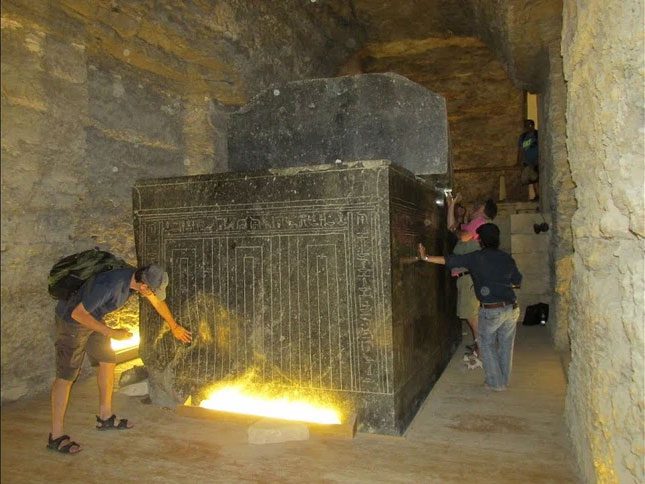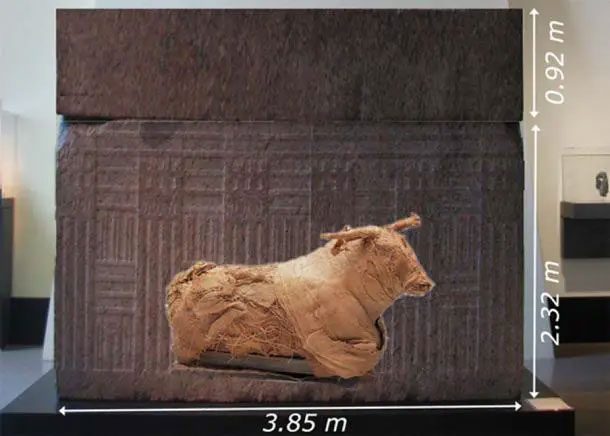At the Saqqara Serapeum temple in Egypt, there are enormous, perfectly square granite sarcophagi weighing hundreds of tons, which have left scientists around the world baffled.
Saqqara Serapeum has been a source of speculation and mystery since its rediscovery in 1850. Even now, no theory can accurately explain how or why more than 20 massive stone sarcophagi were transported to this site and precisely fitted into their grooves.
The mainstream theory posits that this site was used for the burial of the Apis bulls; however, archaeological discoveries suggest many factors that contradict this belief.

Located to the northwest of the Djoser Pyramid in Saqqara, the Saqqara Serapeum is believed by archaeologists to be the burial ground for the Apis bulls, manifestations of the god Ptah – the creator and power of Egypt. This necropolis, located near Memphis, is thought to have been established by Ramses II around 1300 BC. Since its discovery in 1850, the Saqqara Serapeum has puzzled archaeologists and researchers, and the excavated tunnels have become a topic of debate among many. This ancient, majestic labyrinth contains over 20 megalithic “boxes,” weighing between 70 to 100 tons…
For instance, the size of these stone sarcophagi exceeds that of the bulls, leading to a series of other questions such as: Was it made to provide more comfort for the bulls? If so, why not do the same for the pharaohs, who were buried in sarcophagi that fit their bodies? Why were the Serapeum sarcophagi made of granite instead of limestone, a material that is much easier to work with? And if the Serapeum was indeed the burial site for the Apis bulls, where are the mummified bulls?

Comparison of the size of a mummified bull (approximately 2.3 meters long) and a Serapeum sarcophagus based on Linant-Bey’s measurements.
Some dismiss the hypothesis that the Serapeum sarcophagi were used for ceremonial burials, but if not, what were they used for? That is the question posed by some Egyptologists…

Part of these megalithic boxes includes lids weighing 30 tons made from the same stone blocks. When discovered, some of them were opened using explosives, but inside these gigantic boxes were found to be empty. Researchers do not know what they were used for or how they were created thousands of years ago…
For centuries, there have been numerous reports of lights appearing in various shapes and at different times on the ground right before, during, or after earthquakes. A recent case of earthquake light phenomenon was reported in L’Aquila, Italy in 2009, when the area experienced a 6.3 magnitude earthquake. Just before the quake, residents reported seeing lights above the city. This phenomenon was analyzed in detail, and approximately 1,000 people were interviewed. The study concluded that the charges released during the earthquake caused the light effect.

Interestingly, most of these boxes are made of pink granite, an extremely hard stone quarried approximately 800 km away from Saqqara, while other boxes are made from an even harder material – diorite – found even further from Saqqara. The precision of the boxes is another characteristic that leaves researchers or anyone visiting this site puzzled, with deviations noted to one thousandth of an inch.
Although this phenomenon has been known since ancient times, recent video monitoring (installed extensively throughout the city) has enabled researchers to analyze it. Several research groups have done so. A group at San Jose State University, led by Professor Freund, compiled data from 65 different locations worldwide where earthquake lights have been reported. Extensive work has been done to analyze the data and the physical properties behind it. The results indicate that the earthquake light phenomenon is caused by the stress of granite material present in the ground. Verification through theoretical and experimental means has been completed to support these findings.
Therefore, many may wonder whether a similar light mechanism could have been utilized at the Serapeum during pre-dynastic times. When the granite sarcophagi undergo mechanical stress, electric charges may appear. These charges are typically dispersed toward the earth’s surface. When the charges reach the surface, they ionize gas pockets above ground, potentially illuminating the sky above Saqqara.
Thus, at this moment, many believe the enormous Serapeum sarcophagi were used to generate electric charges through pressure created inside by CO2 gas. The pressure acting on quartz crystals has generated charges on the surface of the sarcophagi. These charges were then dispersed from the earth toward the surface. The released charges would ionize the air above Saqqara, causing the air to glow.





















































